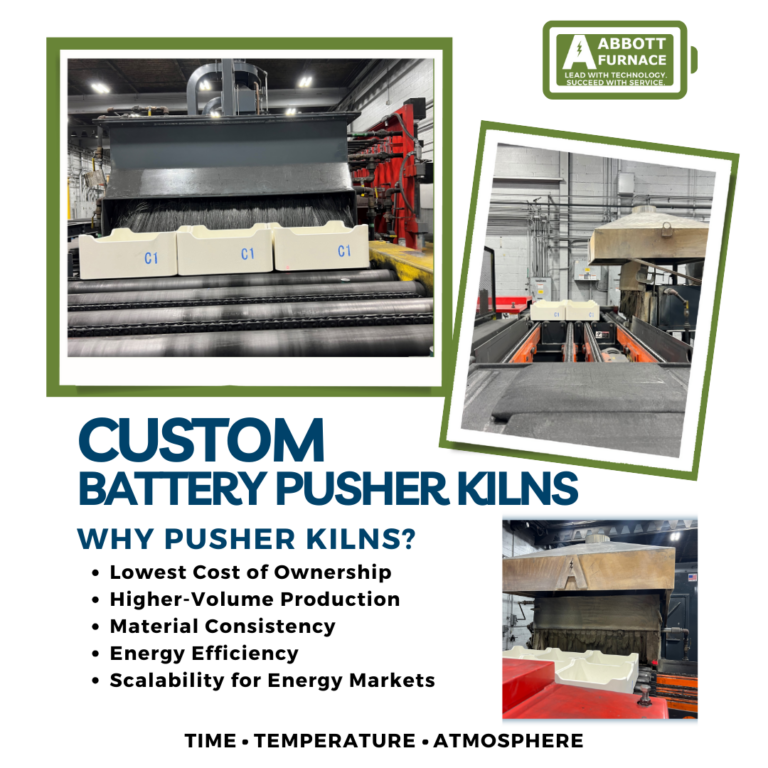Industrial furnaces play a critical role in battery production, particularly in the manufacturing of advanced batteries like lithium-ion (Li-ion) and solid-state batteries. The thermal processes enabled by these furnaces are essential for the production of key components, such as cathode and anode materials, separators, and solid electrolytes. Industrial furnaces are also used in processes like calcination, drying, sintering, and annealing to ensure the materials have the right properties for high-performance energy storage.
Key Roles of Industrial Furnaces in Battery Production
Cathode Material Sintering:
- In lithium-ion batteries, the cathode is a crucial component made from materials like lithium cobalt oxide (LiCoO2), lithium iron phosphate (LiFePO4), or nickel manganese cobalt oxide (NMC). These materials are often synthesized by mixing metal oxides, which are then calcined or sintered at high temperatures in industrial furnaces.
- The high-temperature sintering process improves the crystallinity, particle size distribution, and electrochemical properties of the cathode material, directly influencing battery performance, energy density, and cycle life.
Anode Material Processing:
- Graphite, both natural and synthetic, are commonly used as the anode material in lithium-ion batteries. The production of graphite for battery anodes involves heating carbon-based materials in furnaces at high temperatures (up to 3000°C) to purify and crystallize the material.
Recycling of Battery Materials:
- Industrial furnaces are also essential for the recycling of used batteries. Pyrometallurgical processes, which involve high-temperature furnaces, are used to recover valuable metals such as lithium, cobalt, nickel, and manganese from spent battery cells. These materials can then be purified and reused in the production of new batteries.
- This process is becoming increasingly important as demand for batteries grows, along with the need to reduce the environmental impact of mining raw materials.
Types of Industrial Furnaces Used in Battery Production
Continuous Furnaces:
- These are used for high-volume, continuous processing of battery materials, such as sintering and calcination of cathode materials, as well as drying electrodes and separators.
This type of lab furnace is used to achieve controlled heating, heat treatment, and material testing under elevated temperatures. The push thru lab furnace has two doors, one on each end, much like a typical furnace.
The push thru lab furnace design offers flexibility to adjust time, temperature, and atmosphere profile for testing. This furnace can be multiple heating zones and a 4” tube muffle, and can be run at temperatures up to 2100⁰F/1150⁰C. A high-temperature version of this furnace is possible with a few upgrades to the standard lab furnace, allowing it to run up to 2400⁰F/1315⁰C.
- Furnaces with controlled gas atmospheres (e.g., argon, nitrogen) are used in the sintering of battery materials where oxygen-sensitive processes need to be carried out.
Industrial furnaces are a key technology in the battery production process, enabling the synthesis, purification, and processing of materials like cathodes, anodes, and electrolytes that are crucial to the performance and longevity of batteries. Whether in lithium-ion, solid-state, or future battery technologies, furnaces provide the precise thermal environments needed to achieve the high-quality materials necessary for energy storage applications. As battery demand increases, advances in furnace technology will focus on scalability, energy efficiency, and integration with recycling efforts to support sustainable battery production.
The U.S. Battery Machine Builders is a new initiative dedicated to fortifying the U.S. battery supply chain by encouraging adoption of American-made machines and equipment. Abbott Furnace is united alongside a strong roster of U.S. battery equipment manufacturers to bolster the battery supply chain by manufacturing top-tier equipment in the United States.



